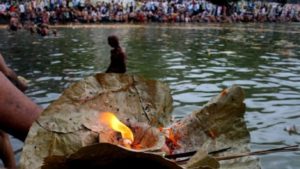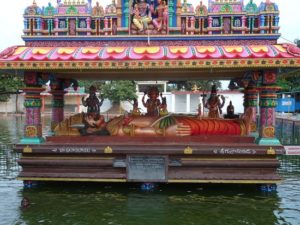To offer Pinda, they come from the different corners of the Earth.
Gaya: The Moksha Bhoomi

As the morning sun rises, setting aside the blanket of clouds dispelling darkness, one can see a large number of people standing knee-deep in the waters of the legendary Falgu River worshipping Surya, in Bihar’s ancient township of Gaya: the Moksha Bhoomi. Among them, one can also notice the presence of foreigners who too are offering Argha to Lord Surya, even though it is a cultural practice that is foreign to them. The eternal spiritual value of Sanatana Dharma seems to have beaconed them here through the centuries.
The tradition of foreigners arriving in India, observing and then following the Hindu religious customs is not a modern phenomenon. One prominent individual was the Chinese scholar, Huan Tsang who had visited Gaya 1400 years ago. Prior to him, another fellow Chinese traveller, translator and Buddhist monk Fa-Hien had meditated on the banks of Falgu River nearly 1700 years ago.
The Falgu River and Gaya are integrally associated with Moksha: the Hindu concept of liberating the human being from the vortex of life and death. Both of the Chinese scholars of Buddhism learned the interpretation of Moksha at the famed city of Gaya which gave rise to a tradition that still continues today. Hundreds of foreigners still throng Gaya in order to attain Moksha. Some of them also embrace Hinduism to seek more knowledge about Atman, or the spirit.

Historically, the first foreigner to formally adopt Hinduism was Heliodorus from Greece. He had adopted Vaishnavism nearly 2200 hundred years ago. The Indo-Greek ambassador of the King Antialcidas in Taxila (now in Pakistan) to the Court of King Bhagabhadra, was influenced to such an extent by the concept of Moksha in particular, and by Hinduism as a whole, that he turned a Hindu himself.
Heliodorus went on to erect a stone pillar dedicated to Lord Vasudeva near Vidisha of Madhya Pradesh in 113 BCE. Still standing tall conveying the paramount significance of Sanatan Dharma, the pillar with the sculpture of Garuda mounted atop, is one of the oldest known inscriptions on Vaishnavism in India.
Tamaso Ma Jyotir Gamaya
Mritur Ma Amritam Gamaya
Lead us from ignorance to truth
Lead us from darkness to light
Lead us from death to deathlessness
The deathlessness or Moksha is the pivot around which the philosophy of Hinduism revolves. It is here where the Moksha Bhoomi – Gaya, located on the banks of the Falgu river comes in. It is here where Pinda or ritualistic morsel of food is offered by people to the departed souls from their families as described in the Hindu scriptures.
The tradition of offering Pinda had a great impact on Fa-Hien, who despite having travelled extensively, had never found a system that as he described in his travelogue, was a “Great Practice” to remember the departed souls, anywhere else in the world. In Sanatana Dharma, it is believed that by offering Pinda at Gaya, one helps departed souls in attaining Moksha.
The tradition of Pinda Daan goes back to ancient times in the timeline of Indian history. Every year about ten lakh Hindus, and also some non-Hindus who are influenced by Hindu traditions, come to this famed ‘Moksha Bhoomi’ where, as per the epic Ramayana as well, Sita had offered Pinda for her father-in-law Dasharatha to facilitate him attaining Moksha.

As the western worldview hardly possesses anything that corresponds with the ritualistic practice of Moksha, an ever increasing number of foreigners numbering in the thousands, visit Gaya in order to learn Hindu scriptures and understand Moksha.
Here, one cannot help but look at Heliodorus whose Greek worldview did not match with Sanatana Dharma, yet he turned a worshipper of Vasudeva, the God of Gods. What he wrote on the pillar at Vidisha, which goes as, “This Garuda-standard of Vasudeva, erected here by the devotee Heliodoros, the son of Dion, a man of Taxila.” is historical proof that Hindu spiritualism has attracted the West even today as it did centuries ago.
According to Garuda Purana, Pinda Daan during Pitrapaksha is necessary. The Rig Veda and the Atharva Veda prescribe it as the most essential ritual for all Hindus to invoke the “Family Spirits” and please them in order to get their blessings.
When Sita Offered “Pinda” to King Dasharatha
In the Ramayana, during Pitrapaksha, Lord Rama, Sita and Laxmana visit Gaya where Sita offers “pinda” to her father-in-law King Dasharatha with a handful of sand only, having no other edible items available. The epic says that during the 12-year period of Vanavasa (exile), their arrival in Gaya coincided with Pitrapaksha: the ideal time for Pinda Daan. Rama is known to have told Sita and Laxmana that they must perform this ritual.
Subsequently, Laxmana goes out to collect the food but does not return in good time. Growing impatient, Rama himself steps out searching for food, leaving Sita behind at River Falgu alongside a banana plant and a cow chewing cud. Rama does not return in time, either. Suddenly, the spirit of Dasharatha appears asking Sita to offer him food. Totally perplexed, Sita says that there is no food to offer. But King Dasharatha’s spirit orders her to offer him some sand from the river Falgu itself, as Pinda. Sita requests the cow, the banana tree and the river Falgu to tell this incident to Ram and Laxman, in case they do not believe her. They all agree.
When Rama and Laxman return with food, and Sita tells them about the incident, they do not believe her. Sita then asks her three witnesses to testify, who now refuse to do so. Enraged by their betrayal, Sita casts curses upon the three. To Falgu, she says: “despite receiving rain, you would always be dry”. To the cow: “everything of you would be ‘pavitra’ (holy) except your mouth that lied”. Sita curses the banana plant with the consequence that it would yield only one fruit in its lifecycle, unlike other trees.
Belief in the historical saga of Ramayana is a matter of faith, but as per Hinduism, a cow’s mouth is considered ‘apavitra’ (holy/unclean), River Falgu is always shallow despite the rain and the banana plant yields only a single cycle of fruit in its lifetime.
When Karna Offered Pinda
As per the Mahabharata, Karna, known as ‘Danveer’ for his generosity, is known to have performed the Pinda Daan. The epic mentions that when he laid dying in the battle of Kurukshetra, his soul travelled to heaven where it was always fed with gold instead of food. Fed up with it, Karna questioned Lord Indra as to why was he always given gold and not food. To which Lord Indra said that ‘it was because he had never offered Pinda to his ancestors and always donated gold in charity.’
As Karna begged for forgiveness, Lord Indra took him to earth for 15-days where the former performed the Pind-Daan ritual in order to obtain regular meals in heaven.
How Was Gaya Born?
In Satya Yuga, demon King Gayasur performed a great ‘Tapassya’ (meditation) at Kolahal Mountain, pleasing Lord Vishnu who blessed him with a boon that any dying man touched by him would go to heaven.

As per Vishnu Purana, Gayasur would sit on the banks of Falgu and touch dying men including the sinners, thus leaving Lord Yama (the judge of the souls and the Hindu God of Death) puzzled as that would play havoc with the ‘Karma’ theory, according to which heaven is not for felons. Yama sought Lord Brahma’s help to solve the problem, who in turn asked Lord Vishnu to convince Gayasur to allow a yagna to be performed on his body, which meant his end. Gayasur agreed.
As he laid down, his body started to cover a vast area of land that eventually became Gaya: The Moksha Bhoomi. Lord Vishnu declared that Gaya would be a ‘pavitra’ (holy) place to offer Pinda. The ritual continues to this day.

Leave a Reply